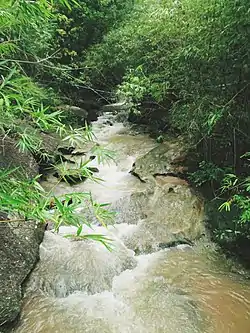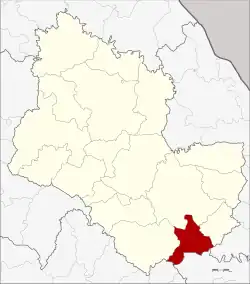Tao Ngoi district
Tao Ngoi (Thai: เต่างอย, pronounced [tàw ŋɔ̄ːj]) is a district (amphoe) of Sakon Nakhon province, northeast Thailand.
Tao Ngoi
เต่างอย | |
|---|---|
 Rapids of Kham Nam Sang Waterfall, Phu Pha Yon National Park | |
 District location in Sakon Nakhon province | |
| Coordinates: 16°57′N 104°09′E | |
| Country | |
| Province | Sakon Nakhon |
| Seat | Tao Ngoi |
| Area | |
| • Total | 328.0 km2 (126.6 sq mi) |
| Population (2005) | |
| • Total | 23,043 |
| • Density | 159.0/km2 (412/sq mi) |
| Time zone | UTC+7 (ICT) |
| Postal code | 47260 |
| Geocode | 4714 |
History
The minor district (king amphoe) was created on 1 September 1978, when the two tambons, Tao Ngoi and Bueng Thawai, were split off from Mueang Sakon Nakhon district.[1] It was upgraded to a full district on 19 July 1991.[2]
The district's name in the Isan language means 'floating turtle'. It is said that 400 years ago, the Thai people and Lao people were at war. When the Lao were defeated, they migrated south to the Pung River. Turtles, a symbol of fertility, were abundant there. Thus the settlement was named for their presence. A giant turtle statue named Phaya Tao Ngoi (พญาเต่างอย; lit: 'turtle lord') was erected in the park behind the district office. In 2017, the popular female luk thung singer Jintara Poonlarp released the song, "Tao Ngoi", bringing increased publicity to the story and the district.[3]
Geography
Neighboring districts are (from the west clockwise) Phu Phan, Mueang Sakon Nakhon and Khok Si Suphan of Sakon Nakhon Province, Na Kae of Nakhon Phanom province, Dong Luang of Mukdahan province, and Na Khu of Kalasin province.
Administration
The district is divided into four sub-districts (tambons), which are further subdivided into 32 villages (mubans). There are no municipal (thesaban) areas, and a further four tambon administrative organizations.
| No. | Name | Thai name | Villages | Pop. | |
|---|---|---|---|---|---|
| 1. | Tao Ngoi | เต่างอย | 7 | 5,619 | |
| 2. | Bueng Thawai | บึงทวาย | 10 | 5,131 | |
| 3. | Na Tan | นาตาล | 7 | 5,363 | |
| 4. | Chan Phen | จันทร์เพ็ญ | 8 | 6,930 |
Economy
Tao Ngoi is the center of tomato production and processing in Thailand. A "tomato belt" of some 30,000 rai are planted in the area. In 1982, the Doi Kham Food Products Co. built a food processing factory in the district. The factory buys 18,000-25,000 tonnes of tomatoes from farmers each year. The Tao Ngoi plant generated revenues of 150 million baht in 2017. Revenue is expected to grow to 200 million baht in 2018.[4]
References
- ประกาศกระทรวงมหาดไทย เรื่อง แบ่งท้องที่อำเภอเมืองสกลนคร จังหวัดสกลนคร ตั้งเป็นกิ่งอำเภอเต่างอย (PDF). Royal Gazette (in Thai). 95 (89 ง): 2829. August 29, 1978. Archived from the original (PDF) on April 27, 2012.
- พระราชกฤษฎีกาตั้งอำเภอทุ่งตะโก อำเภอพะโต๊ะ อำเภอเขาค้อ อำเภอน้ำหนาว อำเภอวังจันทร์ อำเภอนาด้วง อำเภอเต่างอย อำเภอสิงหนคร อำเภอพระสมุทรเจดีย์ และอำเภอลำดวน พ.ศ. ๒๕๓๔ (PDF). Royal Gazette (in Thai). 108 (107 ก Special): 29–33. June 19, 1991. Archived from the original (PDF) on November 8, 2011.
- P., Peeranut (2018-01-16). "เปิดตำนานพญาเต่างอย! ที่เที่ยวศักดิ์สิทธิ์ให้โชคแก่ผู้ศรัทธา". Sanook.com (in Thai).
- Theparat, Chatrudee (22 January 2018). "Tomato belt continues to thrive". Bangkok Post. Retrieved 22 January 2018.